1980 Penny Coin Value: How Much Is It Worth?
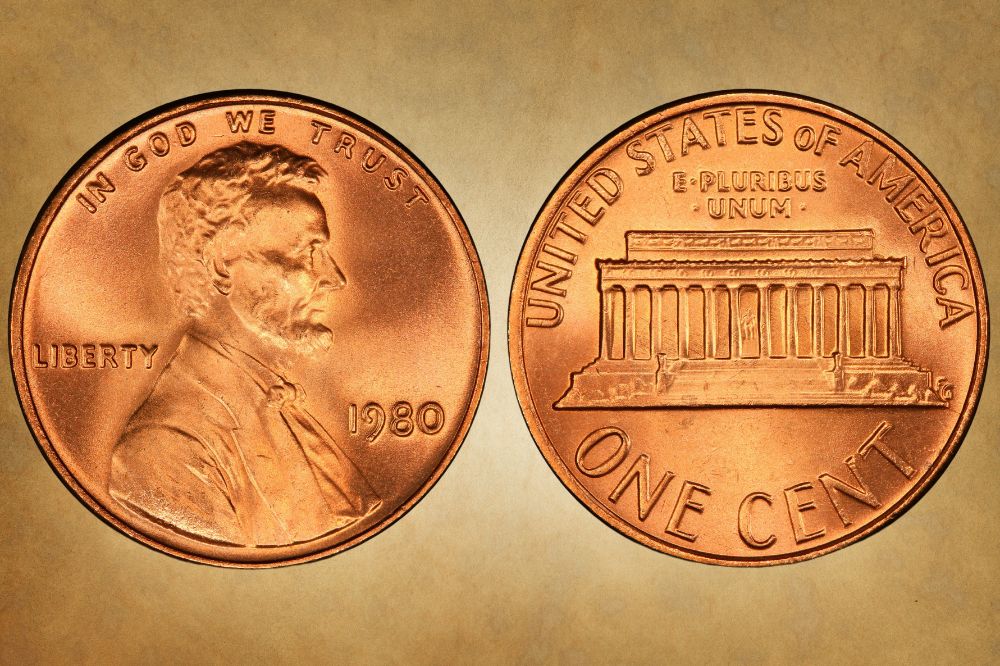
The 1980 penny was one of the series known as Lincoln pennies. If you have one of these coins, could it be worth more than its face value? That’s what we’re here to find out!
We’re going to explore the 1980 penny value. We’ll find out what separates standard coins from those that are interesting and valuable to collectors. And we’ll also take a look at this coin’s history and interesting features along the way.
Ready to find out more? Step this way!
1980 Penny Value Chart |
||||
| Mintmark and Type | MS63 | MS65 | MS67 | MS67+ |
| 1980 RD Penny Value | $5 | $15 | $187 | $2,350 |
| 1980 D RD Penny Value | $6 | $15 | $225 | $1,750 |
| PR64 | PR67 | PR69 | PR70 | |
| 1980 S DCAM Penny (Proof) Value | $3 | $4 | $15 | $2,050 |
1980 Penny Value Guides
1980 No Mint Mark Penny Value
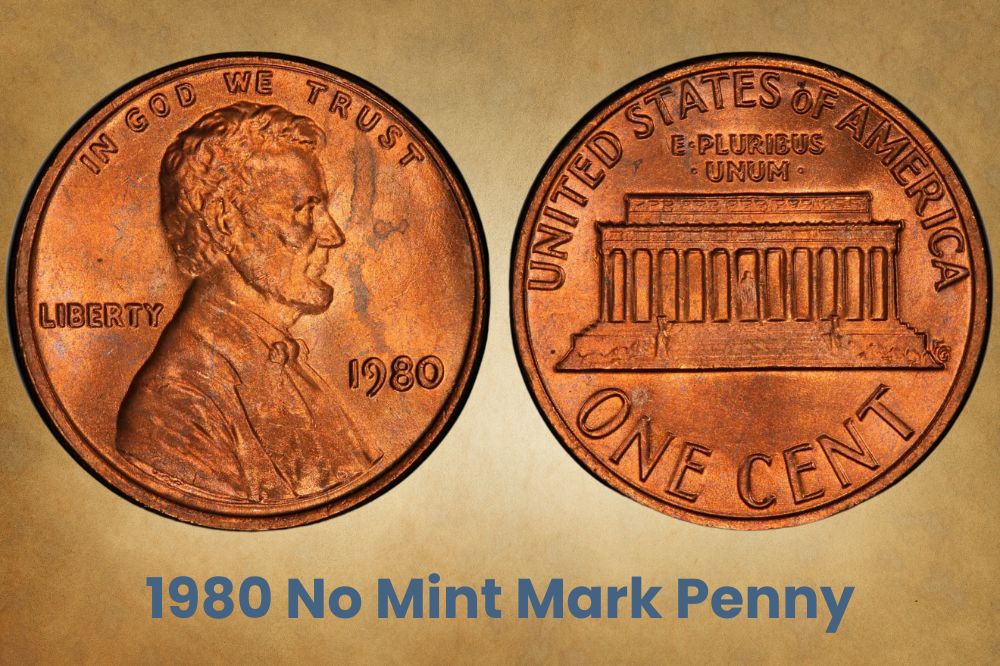
If your 1980 penny doesn’t have a mint mark it could have been struck at either Philadelphia, West Point or San Francisco.
All three facilities struck over a billion coins. Philadelphia was the most prolific, striking over 4.6 billion.
The numbers from West Point (over 1.5 billion) and San Francisco (almost 1.2 billion) are much lower. But as none have a mint mark, there’s no way of distinguishing between them. And that means there’s no premium on their value.
The combination of the large numbers and the relatively recent mintage means that there are still plenty of 1980 pennies out there. And unless you have an error coin – more on those later – circulated examples won’t be worth more than their face value.
In mint state, red coins are more valuable – but prices are generally still modest. At MS63, the PCGS values a 1980 red cent at $5. That increases to $15 for a gem quality red MS65, and $187 at red MS67.
The highest graded example at the PCGS is a sole MS68 red coin. That one is valued at $8,000.
1980 D Penny Value
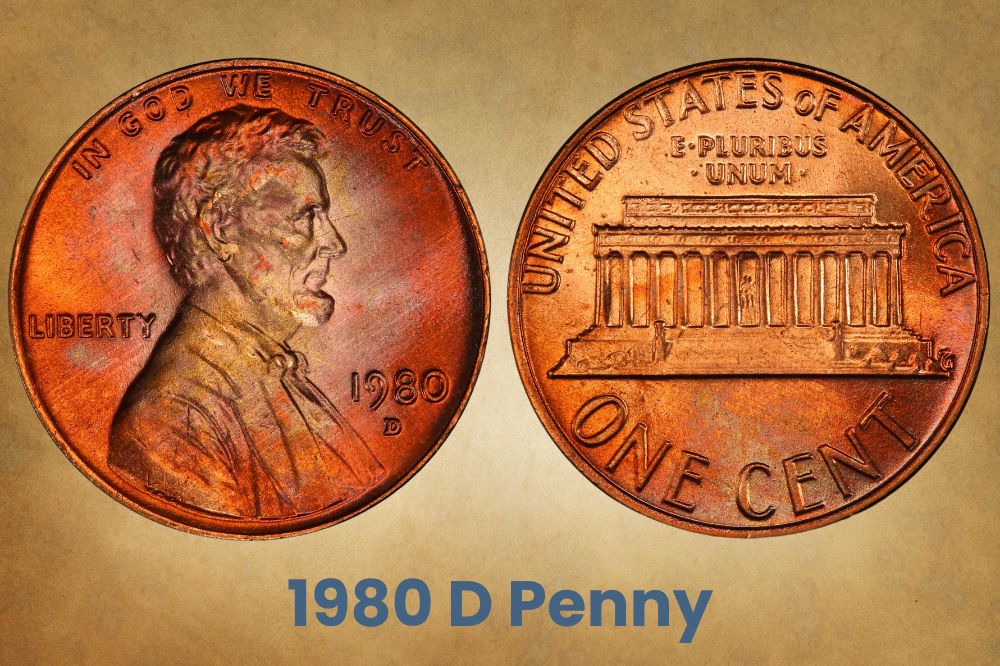
If you have a 1980 cent with a Denver mint mark, you’ll be holding one of 5 billion coins struck there that year. As with unmarked cents, the value of circulated coins won’t be worth more than their face value, unless they have an interesting error.
In lower mint state grades, the value is comparable to unmarked cents. At MS63, a red cent is worth about $5, and at MS65 it will be worth around $15. There’s a slight premium at MS67, where a Denver red cent will be worth about $225, compared to $187 for one without a mint mark.
The finest examples at the PCGS are three coins graded MS67+. They’re each valued at around $1,750.
1980 S (Proof) Penny Value
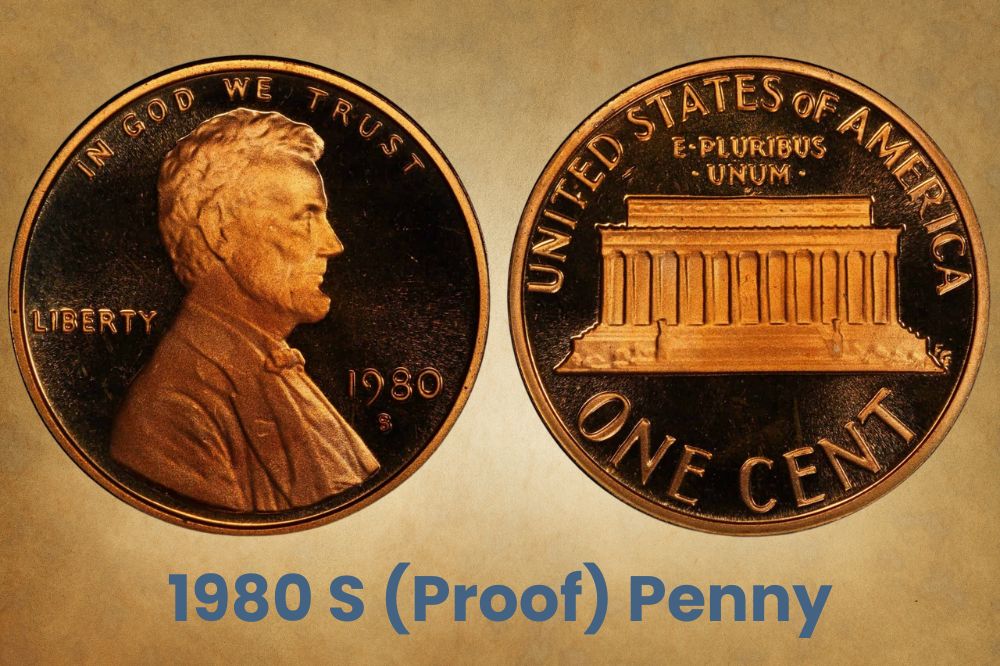
The San Francisco mint facility produced 1980 cents for circulation without a mint mark. But if your 1980 Lincoln cent has an “S” beneath the date, it’s a proof.
Proof coins were struck using specially prepared dies on hand-selected planchets. All the 1980 cents were graded “DCAM” for deep cameo. That means they have an attractive contrast between glossy fields and frosted elements of the design. And they were destined for collectors.
Over 3.5 million 1980 proof cents were struck. And because they were always seen as something special, most will have been carefully stored and kept in good condition. That means that, at most grades, they’re not rare.
Even a proof 1980 cent graded PR67 is worth less than $5. And the value at PR69, one point away from a flawless coin, is just $15. These coins might not be worth big money. But you can own an exceptionally attractive Lincoln penny for as much as a few cups of artisan coffee.
It’s only at PR70 that coins become scarce. To date, the PCGS has graded 70 coins at this level. That’s a big drop from the 4,500+ coins at PR69. Find a PR70, and it will be worth around $2,050.
Related Posts: 16 Most Valuable Wheat Penny Errors
1980 Penny Varieties and Errors
Double Die Obverse
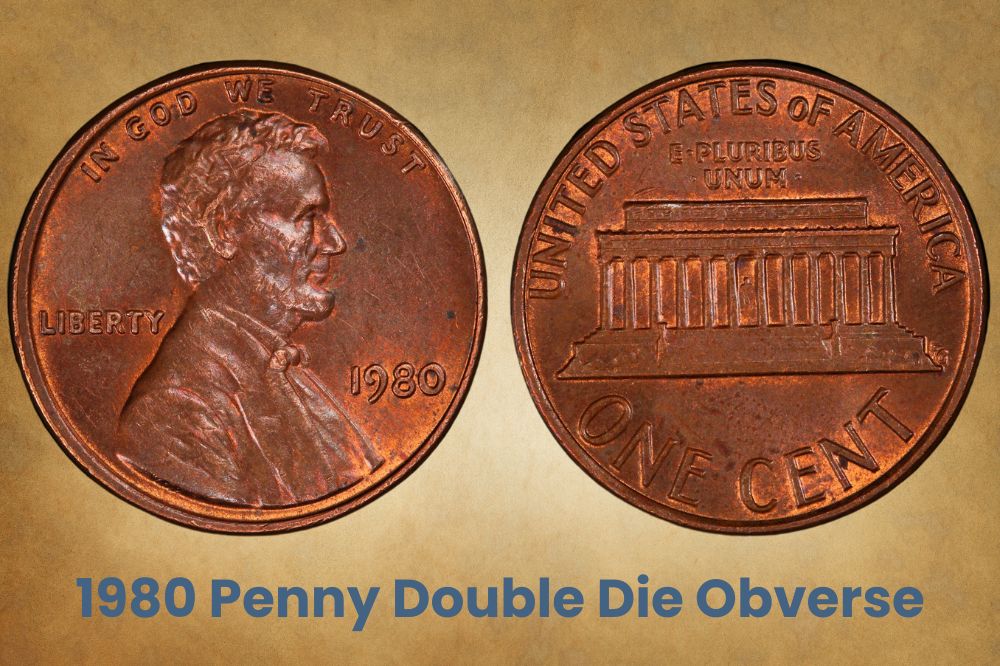
Double die errors occur during the production of the dies made to strike coins. The dies have to be struck repeatedly to capture every element of the design. And if it moves during this process, the result is a double image. This is then transferred onto all the coins struck by the die.
If the doubling is on the die used to strike the design on the “heads” side of the coin, the error is known as a “double die obverse”. And there are a number of 1980 pennies with this type of error.
They’re known on the cents that don’t carry a mint mark. Look for evidence of doubling on all the digits of the date, especially the “1” and the “8”, and the letters of “Liberty”. And you don’t need the coin to be red, or in mint condition, for it to be worth much more than its face value.
A 1980 brown double die obverse cent in even the lowest grades will be worth $3 or $4. At AU55 (“almost uncirculated”) that rises to about $40. And the finest examples at the PCGS, graded MS64, are valued at $150 apiece.
Get your hands on a red coin, and that value will be considerably higher. At MS64, it’ll be worth about $425. That rises to $600 at MS65, and at the finest known grade, MS67, the value is $2,500.
Struck on the Wrong Planchet
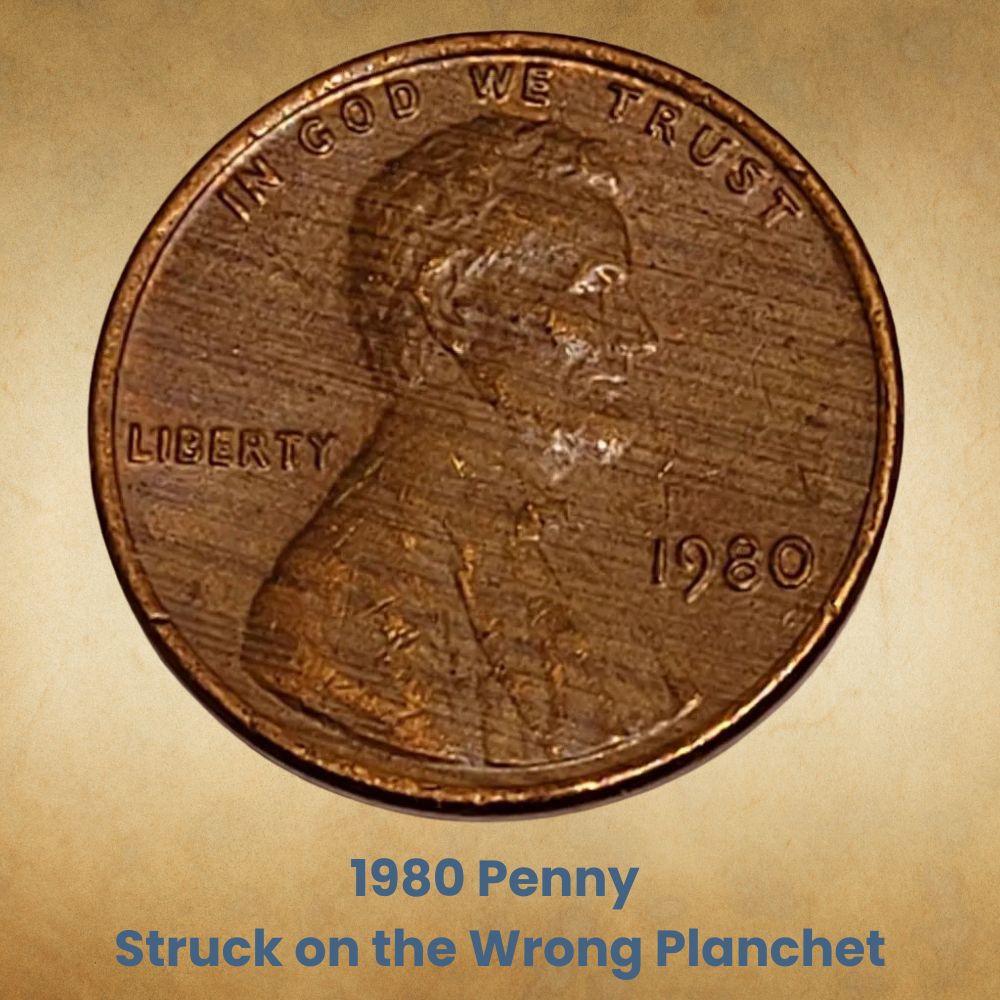
Coins can sometimes be struck on planchets meant for a different denomination. That was the case with one 1980 penny without a mint mark. Instead of being struck on a blank copper planchet, it was struck on a Roosevelt dime.
This type of error is very rare, which also makes it valuable. The coin, graded MS64 by the PCGS, sold at auction for over $1,000.
Striking Errors
Occasionally, coins get stuck in the press and are struck multiple times. That was the case for one 1980 Lincoln penny minted in Denver. It was struck three times. And to add to the interest, the second and third strikes were off center.
The coin was uncirculated too, graded MS62 BN by the NGC. It sold at auction for $345.
This YouTube video from Couch Collectibles looks at a range of different 1980 penny errors.
Related Posts: 19 Most Valuable Lincoln Memorial Penny Worth Money
History of the 1980 Penny
The 1980 penny is one of those often referred to by the nickname the Lincoln Memorial penny. It’s called that because of the image which appears on the reverse.
Pennies bearing the Lincoln’s portrait were first issued in 1909. The year marked a century since the birth of the former president. And all the Lincoln pennies since then show the same image on the obverse.
The earliest coins had a design of two ears of durum wheat on the reverse. But that changed in 1959, marking 150 years since Lincoln’s birth.
The new reverse instead showed the Lincoln Memorial in Washington DC. And if you look closely, you can see the statue of Lincoln in the middle of the portico. That makes the Lincoln Memorial penny one of only a few coins to show the image of the same person on both heads and tails sides.
1980 was one of the last years when the Lincoln cent was made from 95 per cent copper. 1981 saw big rises in the price of copper and it was decided to switch to copper-clad zinc instead.
It wasn’t the first time that the composition of the Lincoln cent had changed. In 1943, coins were made from steel to release copper for the war effort. And in 1973, rising copper prices saw 1.5 million Lincoln cents struck in aluminum (although they all bore the date 1974).
Both the 1943 and 1973 changes were short lived. The steel cents were made for just one year. And when the vending machine industry claimed aluminum coins would jam their machines, the 1970s experiment quickly came to an end.
But the change in the 1980s was altogether different. After various delays, the first new copper-clad zinc cents emerged from the Philadelphia mint facility in 1982. And Lincoln pennies are still being made from copper-clad zinc today.
In 1980, the Mint was striking pennies at four different facilities: Philadelphia, Denver, West Point and San Francisco. The West Point mint struck Lincoln cents for 12 years, but these days it’s used mainly for commemorative coins.
Of the coins produced for circulation, only those struck in Denver have a mint mark. If you see a 1980 penny with an “S” mint mark, it’s a proof. The San Francisco facility produced just over 3.5 million of these for collectors.
Related Posts: 19 Most Valuable Wheat Penny Worth Money
how to identify 1980 Penny
The Obverse of the 1980 Penny
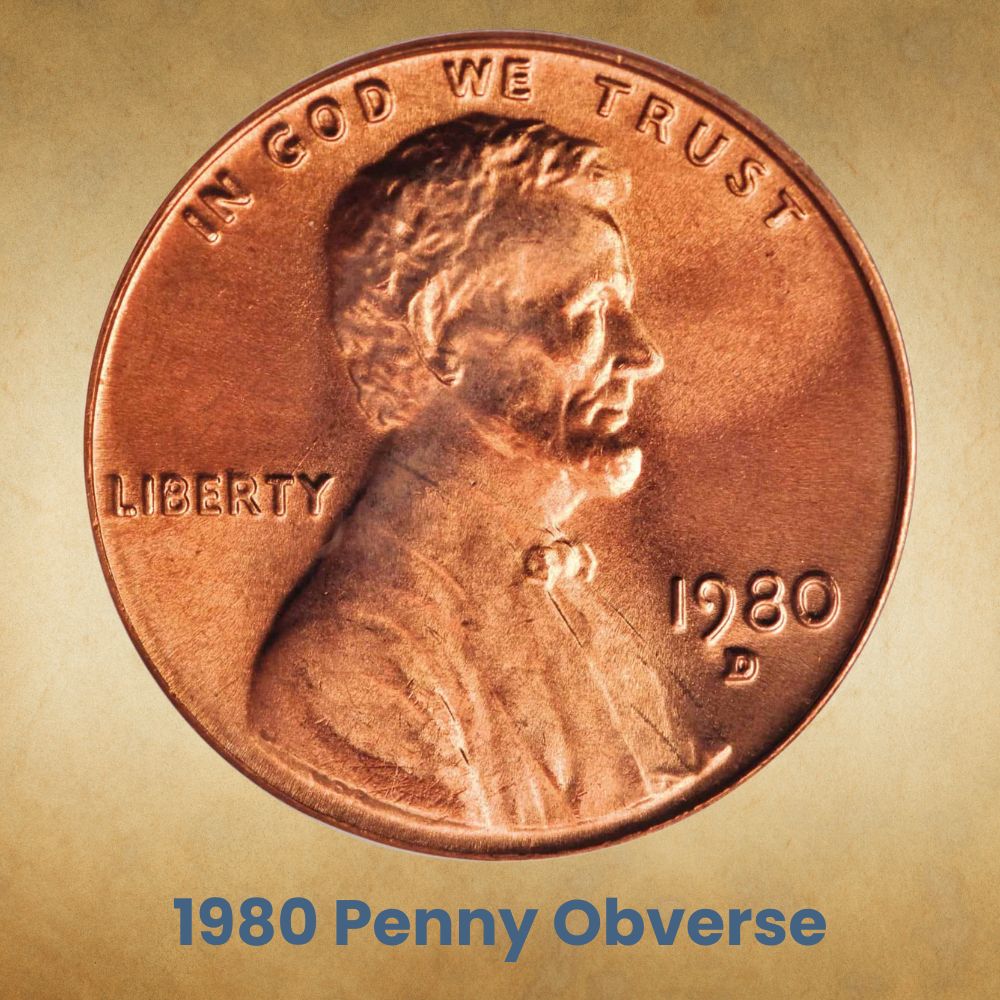
Take a look at the obverse, or heads side, of the 1980 penny, and you’ll see a very familiar image. It’s the same portrait of Abraham Lincoln that’s appeared on every cent since 1909.
It’s the work of a sculptor by the name of Victor David Brenner. Brenner based his image on an earlier photograph of the president, taken at the studio of photographer Matthew Brady. Some people believe it was Brady himself who took the photo, others that it was one of his assistants.
The portrait shows Lincoln’s head and shoulders. We can see his jacket and cravat. And he faces to the right. Brenner wrote in a letter that he had imagined Lincoln as he would look when reading to a child.
Look closely at the lower edge of Lincoln’s shoulder and you’ll see the letters VDB, Brenner’s initials. When the first Lincoln pennies were struck, these had appeared on the reverse. But they immediately caused controversy, with some feeling they were too large and constituted advertising.
As a result, the initials were removed altogether, despite Brenner’s protests, only reappearing in 1918. But this time they were on the obverse, in the position they still enjoy today.
The other elements of the obverse design are just as familiar. Above Lincoln’s bust are the words “In God We Trust”, and “Liberty” is inscribed to the left. On the right, a little further down, is the date.
If your Lincoln penny was minted in Denver, it will also have the mint mark “D” just below the digits. And if it’s a proof minted in San Francisco, there’s be an “S” in the same location.
The Reverse of the 1980 Penny
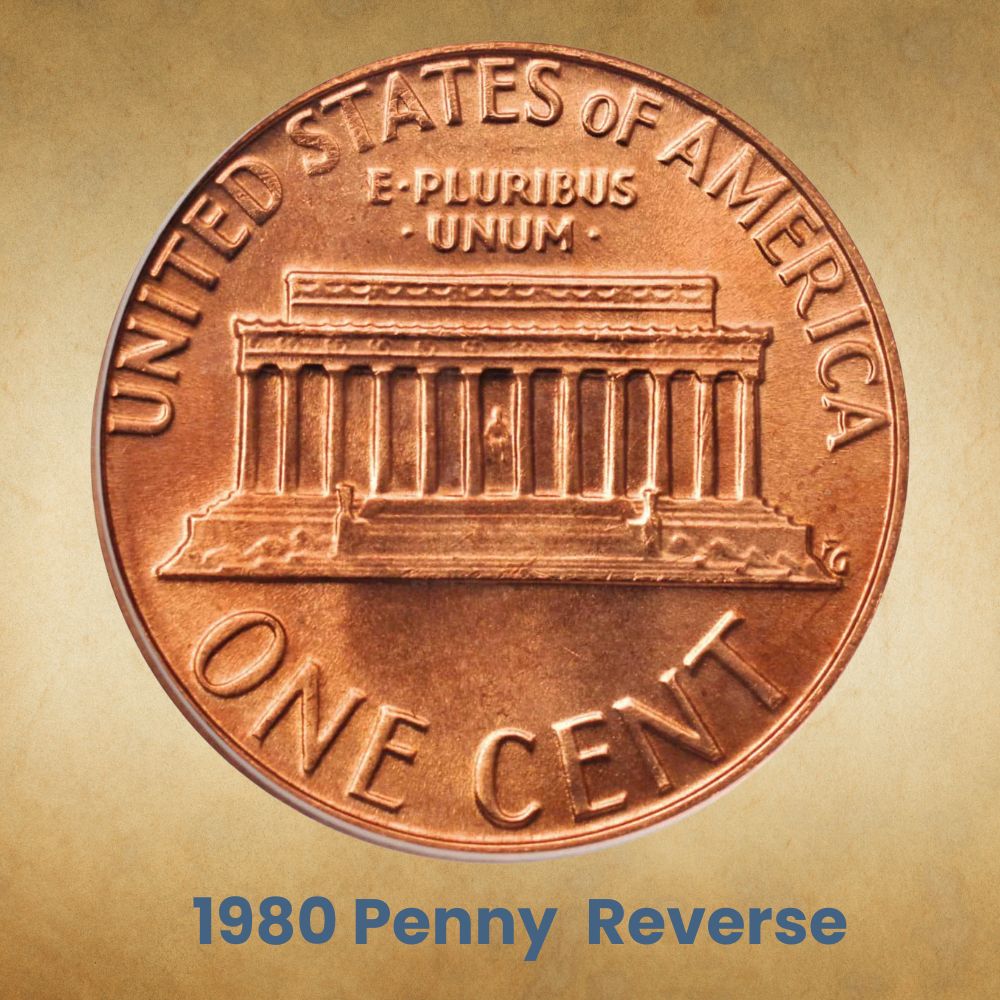
The reverse of the 1980 penny carries the image of the Lincoln Memorial, built in 1922 in Washington DC. It’s the same image that appears on every Lincoln cent struck between 1959 and 2008.
The design was produced by Frank Gasparro. When it was first issued in 1959, Gasparro was Assistant Engraver at the Mint. He was promoted the following year, and he remained the Mint’s Chief Engraver until January 1981.
Immediately above the image of the Memorial is the Latin motto “E pluribus unum”, presented over two lines. It means “From the many, one” and refers to the union of the states creating the USA.
Above it, its line following the curve of the coin, is the name of the country in full. And following the curve of the lower edge is the denomination, also written in full as “One cent”.
Other Features of the 1980 Penny
When looking at copper coins, one of the things you’ll immediately notice is the color. And that can make a big difference to value.
When it’s freshly minted, the metal will be a bright red color. But as it’s handled and exposed to oxygen in the air, the color changes to brown.
A coin grader will look at the shade and designate it accordingly. If a coin is red on at least 95 per cent of its surface area on both sides, it will be designated “red”. You’ll see the letters “RD” in the coin description.
If it’s at least 95 per cent brown, it will be designated “brown”. In this case, the letters “BN” will appear in the description.
And if it’s somewhere in between, it’s “red and brown” or “RB”.
All other things being equal, a coin graded red will be worth more to collectors than one graded red and brown. And one graded red and brown will be worth more than one graded brown.
For relatively modern copper coins, like the 1980 penny, it’s usually only red uncirculated coins that are worth much more than their face value.
Check out this YouTube video from CoinOpp to see all the different designs of Lincoln cents.
FAQs
Are pennies from 1980 worth anything?
The vast majority of 1980 pennies aren’t worth anything more than their face value. But there are rare exceptions.
The finest quality coins with a red tone can be considerably more valuable. At the very highest grades, they can make three, or even four figure prices.
And error coins can be valuable too, even if they’re not in pristine condition. Look for coins with doubling on the obverse – focus on the date and the letters of the word “Liberty”.
And rarer errors, like coins struck off-center or on the wrong planchet, can be worth serious money.
How much is a 1980-D mint mark penny worth?
Denver produced more 1980 cents than any other individual mint facility. That means that finding a 1980 penny with a D mint mark isn’t difficult. And most won’t be worth more than a cent.
But as with all 1980 pennies, the finest uncirculated condition, or a rare error can make them valuable.
